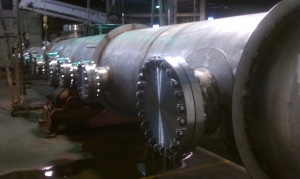A fantastic Article found on: http://www.csb.gov/newsroom/detail.aspx?nid=293
November 09, 2009
Without appropriate safeguards, pressure vessels can pose lethal dangers.Washington, DC, November 9, 2009 – CSB Chairman John Bresland released a new video safety message today asking jurisdictions across the country to adopt the ASME Pressure Vessel Code to reduce the number of accidents involving catastrophic pressure vessel failures in process industries.The safety message can be viewed on CSB.gov and on the CSB’s safety message channel,www.youtube.com/safetymessages.In the safety message, Chairman Bresland warned that without appropriate safeguards, pressure vessels can pose lethal dangers. Chairman Bresland said, “Pressure vessels store tremendous amounts of energy and you should never become complacent about the risks.”Particular danger exists when vessels are improperly installed, welded, or modified, or when they lack effective pressure relief systems. Mr. Bresland refers to several incidents investigated by the CSB including an explosion at a Louisiana natural gas well that killed four workers when a tank rated only for atmospheric pressure was exposed to gas pressure up to 800 pounds per square inch.In April 2003, an 8-foot tank used to heat sugar caramel exploded when the vent line became blocked, killing an overnight operator, releasing large amounts of ammonia, and forcing a community evacuation. The vessel had no pressure-relief system.Additionally, in 2004 a pressure vessel weighing 50,000-pounds exploded at a chemical plant in Houston, Texas, throwing heavy fragments into the community, which damaged a church and businesses. The CSB found that the company improperly modified and welded the vessel.Chairman Bresland stated that these accidents can be avoided if states implement long-established codes for safe use. He said, “There are only eleven states that do not require companies to follow the Pressure Vessel Code of the American Society of Mechanical Engineers (ASME). I ask all jurisdictions to adopt the Pressure Vessel Code and related boiler standards. Lives will be saved as a result.”The ASME Code provides the fundamental safeguards for pressure vessels, including design, welding procedures and fabrication, testing, and pressure relief. In 2006, the CSB called upon the City of Houston to adopt the Code to protect residents and industrial facilities from these incidents. However, Houston has failed to implement this recommendation despite reoccurring pressure vessel failures such as a summer of 2008 heat exchanger explosion in a resin-production facility that killed a veteran supervisor.The CSB is an independent federal agency charged with investigating industrial chemical accidents. The agency’s board members are appointed by the president and confirmed by the Senate. CSB investigations look into all aspects of chemical accidents, including physical causes such as equipment failure as well as inadequacies in regulations, industry standards, and safety management systems.The Board does not issue citations or fines but does make safety recommendations to plants, industry organizations, labor groups, and regulatory agencies such as OSHA and EPA.

